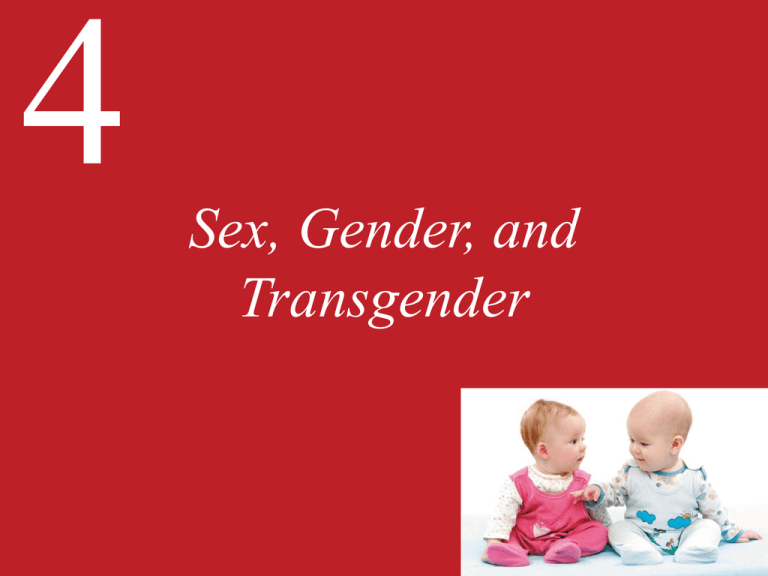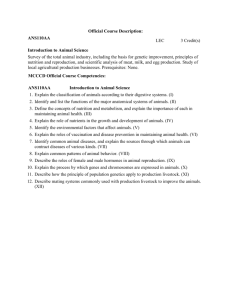
4
Sex, Gender, and
Transgender
Chapter 4: Sex, Gender, and Transgender
• Genes and Hormones Guide Sex
Development
• Sex Development May Go Awry
• Gender Is a Central Aspect of Personhood
• There Are Many Sex Differences in Sexuality
• Biological Factors Influence Gender
• Life Experiences Influence Gender
• Gender Development Is Interactive
• Transgender People Cross Society’s
Deepest Divide
Genes and Hormones Guide Sex Development
Sex chromosomes determine the development
of an embryo:
• An embryo with two X chromosomes
develops as a female.
• An embryo with one Y chromosome and
one X chromosome develops as a male.
The sex-determining gene, called SRY, is
located on the Y chromosome.
Its presence directs sexual development along
the male pathway.
Figure 4.1 Human chromosomes
Genes and Hormones Guide Sex Development
Female and male embryos possess both
Wolffian and Müllerian ducts.
• Wolffian ducts are precursors of the
male reproductive tract.
• Müllerian ducts are precursors of the
female reproductive tract.
Genes and Hormones Guide Sex Development
In males, testes produce anti-Müllerian
hormone (AMH), which causes the female
ducts to regress, and testosterone, which
stimulates the Wolffian ducts to produce
male internal organs.
In females, the absence of AMH allows
Müllerian ducts to persist and develop into
the oviducts, uterus, and deeper parts of
the vagina.
Figure 4.2 Development of the male and female reproductive tracts
Genes and Hormones Guide Sex Development
Female and male external genitalia develop
from the same precursors.
Each embryo has a slit, the cloaca, which is
covered by a membrane.
The cloaca is flanked by two urethral folds
and, outside those, the genital swelling.
At the middle of the front end of the cloaca is
the genital tubercle.
Figure 4.3 Development of the male and female external genitalia (Part 1)
Figure 4.3 Development of the male and female external genitalia (Part 2)
Genes and Hormones Guide Sex Development
The urethral folds become
• Inner labia in females
• Shaft of the penis in males
The genital swellings give rise to
• Outer labia in females
• Scrotum in males
Genes and Hormones Guide Sex Development
The genital tubercle forms
• External portion of clitoris in females
• Glans of the peinis in males
In the absence of SRY and testosterone,
female external genitalia develop—the
default.
Figure 4.3 Development of the male and female external genitalia (Part 3)
Genes and Hormones Guide Sex Development
In both sexes, the gonads begin near the
kidneys and descend as development
progresses.
By 10 weeks, the gonads are near the top of
the pelvis.
• In females, they stay here until birth.
• In males, the gonads continue to
descend. Shortly before birth, they reach
the scrotum.
Figure 4.4 Descent of the testicles (Part 1)
Figure 4.4 Descent of the testicles (Part 2)
Genes and Hormones Guide Sex Development
In 2% to 5% of newborn boys, one or both
testicles have not descended into the
scrotum.
• Testicles usually arrive within a few weeks
of birth.
• If testicles have not arrived by 3 months,
the condition is called cryptorchidism
and must be surgically moved.
Increased
risk of cancer
Genes and Hormones Guide Sex Development
There are differences in brain structure,
function, and chemistry between the two
sexes.
• Men’s brains are about 10% larger—
proportionate to overall body size
difference.
• Connections between left and right
hemispheres are stronger in women;
connections within each side of the brain
are stronger in men.
Genes and Hormones Guide Sex Development
• Men use their right amygdala more, and
women use their left amygdala more.
• Men’s brains produce 52% more
serotonin than women’s brains.
• Women’s brains produce much more
dopamine than men’s brains.
These differences are attributed to the
different levels in circulating androgen
levels between females and males during
development.
Figure 4.5 Sex differences in the cerebral cortex
Sex Development May Go Awry
Chromosomal anomalies affect growth and fertility.
• Klinefelter syndrome (XXY, XXXY): male, tall,
low testosterone, small genitals, low sperm count
• Turner syndrome (XO): female, short, lack
normal ovaries, require assistance to enter
puberty
• XYY syndrome: male, may have genital
anomalies, atypical cerebral cortex development
• Triple-X syndrome: female, mild cognitive
deficits, low fertility
Figure 4.6 Turner syndrome
Sex Development May Go Awry
The gonads or genitals may be sexually
ambiguous.
• Gonadal intersexuality: possession of
ovarian and testicular tissue, most look like
women, usually infertile
• Congenital adrenal hyperplasia (CAH): XY
“females,” lack reproductive tract, shallow
vagina, infertile
• Androgen Insensitivity Syndrome (AIS):
XX fetus that experienced large amounts of
androgens, partial masculinization of genitals
Figure 4.7 Partial masculinization of genitalia
Box 4.1 Katie Baratz Dalke
Gender Is a Central Aspect of Personhood
Gender identity is the personal sense of which
sex one belongs to. For some people, gender
identity does not match their anatomical sex.
Gender identity is expressed via gender role
behavior: clothing choices, walk, talk, etc.
Sexual orientation, cognition, and personality
traits differ between men and women.
Differences in sexuality include attitudes toward
casual sex, jealousy, and frequency of
masturbation.
Gender Is a Central Aspect of Personhood
Cognitive differences between sexes vary,
but less so than physical differences, such
as average height.
Men tend to score higher than women on
verbal and physical aggression
evaluations.
Women’s interests tend to be more people
related and empathetic; men’s interests
tend to be more related to things.
Figure 4.8 Mental rotation task
Figure 4.9 Female superiority in face recognition
Gender Is a Central Aspect of Personhood
Sexuality differences
• Men have a stronger sex drive.
• Men express more permissive attitudes
toward casual sex.
• Women are typically attracted to older
partners, and men to younger ones.
• Men are more concerned than women
with physical attractiveness of partner.
Gender Is a Central Aspect of Personhood
Sexuality differences
• Women are more likely to experience
emotional jealousy, and men sexual
jealousy.
• Men are more likely to engage in unusual
forms of sexual expression.
• Women are less likely to pay for sex and
more likely to receive money for sex.
• Women and men have different sexual
response cycles.
Gender Is a Central Aspect of Personhood
Many gender differences arise at a young age:
• Male fetuses are more active than female
fetuses.
• By about 3 months of age, most children
show sex differences in toy preferences.
• By about 4 years of age, most boys prefer to
play with boys, and most girls with girls.
• Girls play is more governed by social
conventions, and boys by principles of justice.
Figure 4.10 Toy preference test
Biological Factors Influence Gender
Evolutionary factors influence gender
development:
• Casual sex is less costly for men than
women.
• Jealousy—no certainty of which man
fathered a particular child
Biological Factors Influence Gender
• Cognitive differences may be due to
long-standing division of labor between
men and women.
Box 4.2 Monkeys show humanlike toy preferences
Biological Factors Influence Gender
In girls with CAH, some, but not all,
behavioral traits are shifted in the
masculine direction.
Higher prenatal androgen levels shift
behaviors of girls and boys in the
masculine direction.
The lower the levels of fetal testosterone in
girls, the stronger her preference for “girl
toys” when she is 3 years old.
Figure 4.11 Hormones and play
Biological Factors Influence Gender
The ratio of the index-finger length to the
ring-finger length is an anatomical marker
in adults that may reflect the degree to
which people were exposed to testosterone
prenatally.
The 2D:4D ratio correlates with many
gendered characteristics.
Figure 4.12 Finger length ratio and gender
Life Experiences Influence Gender
Life experiences influence gender
development beginning early in life:
• Observing socialization
• Rewards and punishments
• Imitation
• Language
• Gender learning from advice
Figure 4.13 Babies enter a gendered world
Figure 4.14 Influence of siblings on gender
Figure 4.15 The media influence gender
Box 4.3 David Reimer (1965–2004)
Life Experiences Influence Gender
Cognitive models focus on thought
processes
• Sexual script theory
Transgendered People Cross Society’s Deepest Divide
Gender development is interactive.
Transgender people cross society’s deepest
divide.
Trans men and women have probably
existed in all human societies.
Box 4.4 Members of the Thai ladyboy (transgender) band Venus Flytrap
Transgendered People Cross Society’s Deepest Divide
Transexual individuals are of more than one
kind.
• F-to-M transexuals (trans men)
• M-to-F transexuals (trans women)
• Transvestism
• Autogynephilia
Transgendered People Cross Society’s Deepest Divide
Transexual is the term generally used for
transgender individuals who seek to medically
change their body to the other sex.
Sex-reassignment, transitioning, is a
multistage process.
• Psychological and physical evaluation
• Real-life experience
• Hormone treatment
• Sex-reassignment surgery
Figure 4.17 Chastity Bono (left), transitioned to Chaz Bono (right) between 2008 and 2010
Transgendered People Cross Society’s Deepest Divide
For transexual women, key surgical
procedures include:
• Removing penis and testicles
• Constructing vagina, labia, and clitoris
• Breast augmentation
Transgendered People Cross Society’s Deepest Divide
For transexual men, key surgical procedures
include:
• Removing ovaries, uterus, and vagina
• Constructing scrotum and penis
• Removal of breasts
Transgendered People Cross Society’s Deepest Divide
Age at time of medical treatment seems very
important, so some centers are now
treating children at or before puberty.
Box 4.5 Monozygotic (“identical”) twins Jonas and Nicole Maines photographed in 2013 at age 16
Transgendered People Cross Society’s Deepest Divide
Some transgender people do not want surgery.
• Contradiction of inner and outer life may not
bother them.
• Medical route may not be affordable.
• Less than ideal results may not be worth it.
• Cross-dressing, passing as other sex, may
be satisfactory.
• Freedom to switch roles may valuable.
• Not passing as opposite sex may provide
satisfaction.
Figure 4.20 Kate Bornstein
Transgendered People Cross Society’s Deepest Divide
Trans people struggle for awareness and
acceptance. Trans people
• Are relatively few in number
• Work to clarify their unique identity
• Are at greater risk of violence and
discrimination
Transphobia: Hatred of transgender people
Figure 4.21 Transgender teen








